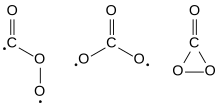Carbon trioxide

| |
 The Cs, D3h, and C2v isomers of carbon trioxide
| |
| Names | |
|---|---|
| IUPAC names
Carbon trioxide
C2v isomer:
D3h isomer:
| |
| Systematic IUPAC name
C2v isomer:
D3h isomer:
| |
| Other names
Cs isomer:
| |
| Identifiers | |
3D model (JSmol)
|
|
PubChem CID
|
|
| |
| |
| Properties | |
| CO3 | |
| Molar mass | 60.008 g·mol−1 |
Except where otherwise noted, data are given for materials in their standard state (at 25 °C [77 °F], 100 kPa).
| |
Carbon trioxide (CO3) is an unstable oxide of carbon (an oxocarbon). The possible isomers of carbon trioxide include ones with molecular symmetry point groups Cs, D3h, and C2v. The C2v state, consisting of a dioxirane, has been shown to be the ground state of the molecule.[1] Carbon trioxide should not be confused with the stable carbonate ion (CO2−
3).
Carbon trioxide can be produced, for example, in the drift zone of a negative corona discharge by reactions between carbon dioxide (CO2) and the atomic oxygen (O) created from molecular oxygen by free electrons in the plasma.[2] Another reported method is photolysis of ozone O3 dissolved in liquid CO2, or in CO2/SF6 mixtures at −45 °C, irradiated with light of 253.7 nm. The formation of CO3 is inferred but it appears to decay spontaneously by the route
- 2 CO3 → 2 CO2 + O2
with a lifetime much shorter than 1 minute.[3] Carbon trioxide can be made by blowing ozone at dry ice (solid CO2), and it has also been detected in reactions between carbon monoxide (CO) and molecular oxygen (O2). Along with the ground state C2v isomer,[4] the first spectroscopic detection of the D3h isomer was in electron-irradiated ices of carbon dioxide.[5]
References
[edit]- ^ T. Kowalczyk; A. I. Krylov (Aug 2007). "Electronic structure of carbon trioxide and vibronic interactions involving Jahn–Teller states". J. Phys. Chem. A. 111 (33): 8271–8276. Bibcode:2007JPCA..111.8271K. doi:10.1021/jp073627d. ISSN 1089-5639. PMID 17661455.
- ^ Sabin, J. R; Kim, H (1971). "A theoretical study of the structure and properties of carbon trioxide". Chemical Physics Letters. 11 (5): 593–597. Bibcode:1971CPL....11..593S. doi:10.1016/0009-2614(71)87010-0.
- ^ DeMore W. B.; Jacobsen C. W. (1969). "Formation of carbon trioxide in the photolysis of ozone in liquid carbon dioxide". Journal of Physical Chemistry. 73 (9): 2935–2938. doi:10.1021/j100843a026.
- ^ Bennett, Chris J.; Jamieson, C.; Mebel, Alexander M.; Kaiser, Ralf I. (2004). "Untangling the formation of the cyclic carbon trioxide isomer in low temperature carbon dioxide ices". Physical Chemistry Chemical Physics. 6 (4): 735. Bibcode:2004PCCP....6..735B. doi:10.1039/b315626p. S2CID 51769127.
- ^ Jamieson, Corey S.; Mebel, Alexander M.; Kaiser, Ralf I. (2006). "Identification of the D3h Isomer of Carbon Trioxide (CO3) and Its Implications for Atmospheric Chemistry". ChemPhysChem. 7 (12): 2508–2513. doi:10.1002/cphc.200600390. PMID 17029325.
Further reading
[edit]- Sobek V.; Skalný J. D. (1993). "A simple model of processes in the drift region of negative corona discharge in a mixture of air with halocarbons". Czechoslovak Journal of Physics. 43 (8): 807. Bibcode:1993CzJPh..43..807S. doi:10.1007/BF01589802. S2CID 120356317.
- Pople J. A.; Seeger U.; Seeger R.; Schleyer P. v. R. (2004). "The structure of carbonate". Journal of Computational Chemistry. 1 (2): 199–203. doi:10.1002/jcc.540010215. S2CID 98748631.
- Moll N. G.; Clutter D. R.; Thompson W. E. (1966). "Carbonate: Its Production, Infrared Spectrum, and Structure Studied in a Matrix of Solid CO2". The Journal of Chemical Physics. 45 (12): 4469–4481. Bibcode:1966JChPh..45.4469M. doi:10.1063/1.1727526.
- Gimarc B. M.; Chou T. S. (1968). "Geometry and Electronic Structure of Carbon Trioxide". The Journal of Chemical Physics. 49 (9): 4043–4047. Bibcode:1968JChPh..49.4043G. doi:10.1063/1.1670715.
- DeMore W. B.; Dede C. (1970). "Pressure dependence of carbon trioxide formation in the gas-phase reaction of O(1D) with carbon dioxide". Journal of Physical Chemistry. 74 (13): 2621–2625. doi:10.1021/j100707a006.
- Francisco J. S.; Williams I. H. (1985). "A theoretical study of the force field for carbon trioxide". Chemical Physics. 95 (3): 373. Bibcode:1985CP.....95..373F. doi:10.1016/0301-0104(85)80160-9.
